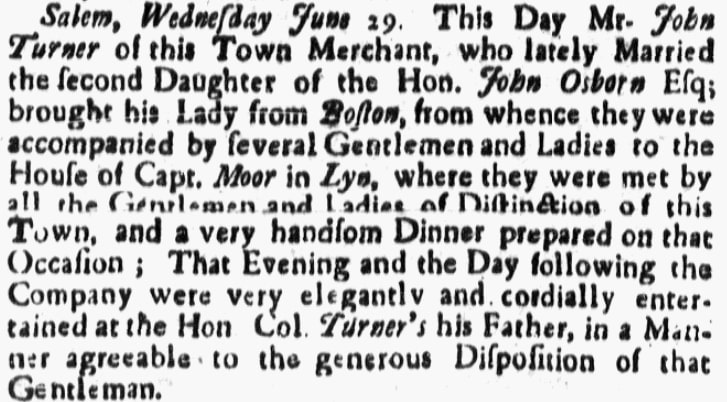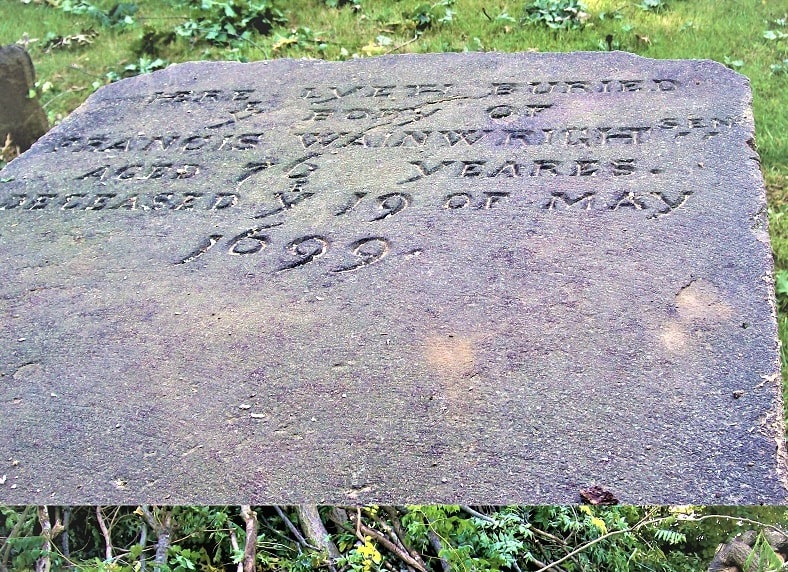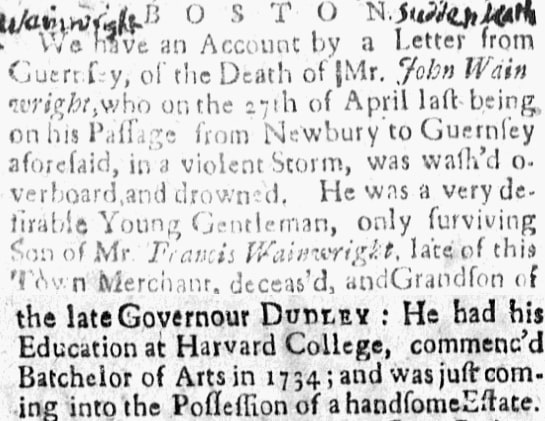Introduction: In this article, Melissa Davenport Berry continues her story about a controversy in Salem, Massachusetts, over the treatment of some Quaker tombs in 1835, focusing on the Turner, Berry and Wainwright families. Melissa is a genealogist who has a blog, AnceStory Archives, and a Facebook group, New England Family Genealogy and History.
Author’s Note: I came across this story while researching the 17th century Quaker families in Salem, Massachusetts. They are the ancestors of the tombs in Salem that are the focus of today’s story. A list of these Salem Quakers can be found in Jonathan M. Chu’s book Neighbors, Friends, or Madmen: The Puritan Adjustment to Quakerism in Seventeenth-Century Massachusetts Bay (p. 169-173). These Quakers are also cited in the court documents available online at the University of Virginia site.
To recap: In 1835 the Board of Health in Salem placed an announcement in the newspaper which created a sensation. The board reported that several tombs in public burial grounds were in a ruinous state, and requested owners to come forward to mark the appropriate names and fix up the tombs. For tombs left unclaimed or undefined, the board announced that it would repair – and then sell – those tombs.
The Sargent family was one of the parties who contested the Board of Health’s outrageous plan. They were the descendants of Mary Turner and Daniel Sargent, who married in 1763. In researching about two of the tombs affected by the Board’s announcement – the Turner and the Wainwright tombs – I found information about the Turner, Berry and Wainwright families, the subject of today’s story.

Interesting note: Mary was the daughter of John Turner III and Mary Osborne (daughter of John Osborne and Mary Woodbury). John Turner III and Mary (Osborne) Turner were the last of three Turner generations to reside in the home made famous by Nathaniel Hawthorne’s novel The House of the Seven Gables.
I found a marriage announcement for John and Mary in the Boston Gazette; they were married on 29 June 1738.

It reads:
Salem, Wednesday, June 29. This day, Mr. John Turner of this town, merchant, who lately married the second daughter [Mary] of the Hon. John Osborn[e], Esq., brought his lady from Boston, from whence they were accompanied by several gentlemen and ladies to the house of Capt. Moor in Lyn, where they were met by all the gentlemen and ladies of distinction of this town, and a very handsome dinner prepared on that occasion; that evening and the day following the company were very elegantly and cordially entertained at the Hon. Col. Turner’s, his father, in a manner agreeable to the generous disposition of that gentleman.
John Turner III was the Master and Commanding Officer of the Franklin, 220 tons, 18 guns, and 100 men, during the Revolutionary War. In May 1781 Turner and crew captured a Liverpool ship after an engagement. I found a report on this event in the Newport Mercury.

It reads:
Boston, May 28. Last Sunday arrived at Salem, the privateer ship Franklin, Capt. Turner, of that port, having had the misfortune to have her mainmast disabled in an engagement of 40 minutes with a large ship from Liverpool bound to New York, which proved a valuable prize, but is yet not arrived. The Franklin had one man killed, and one wounded; on board the prize was two killed, and eight wounded.
After the death of his wife Mary, John III married Catherine Berry, daughter of Capt. John and Katherine (Manning) Berry.
John’s sister Elizabeth Turner married Dr. Thomas Berry. Later, the sale of this couple’s house revealed a connection to another tomb listed in the Salem Board of Health’s 1835 announcement: the Wainwright tomb. Dr. Berry had purchased the home from a Francis Wainwright.

The Wainwright tomb was erected in 1680 for the first Francis Wainwright. The inscription reads:
“Here lyeth buried ye body of Francis Wainwright, Aged 76 yeares, Deceased ye 19 of May 1699.”
The tablet was restored in 1894 and the record is inscribed on the stone.
Francis was a merchant and honored soldier. He married Phillipa Sewell, and their children married into the family lines of Proctor, Perkins, Norton, Shephard, Rolfe, Whipple, and Cogswell.
An obituary in the New-England Weekly Journal for John Wainwright, gr. grandson of Francis, provides more family information.

It reads:
Boston. We have an account by a letter from Guernsey, of the death of Mr. John Wainwright, who on the 27th of April last, being on his passage from Newbury to Guernsey aforesaid, in a violent storm was wash’d overboard and drowned. He was a very desirable young gentleman, only surviving son of Mr. Francis Wainwright, late of this town, merchant, deceased, and grandson of the late Governour Dudley. He had his education at Harvard College, commenc’d Batchelor of Arts in 1734; and was just coming into the possession of a handsome estate.
John Wainwright’s mother was Mary Dudley, daughter of Gov. Joseph Dudley and Rebecca Tying.
Stay tuned for more on the Salem tombs…
Note: Just as an online collection of newspapers, such as GenealogyBank’s Historical Newspaper Archives, helped tell the stories of the families connected to the Salem tombs, they can tell you stories about your ancestors that can’t be found anywhere else. Come look today and see what you can discover!
Related Articles:
